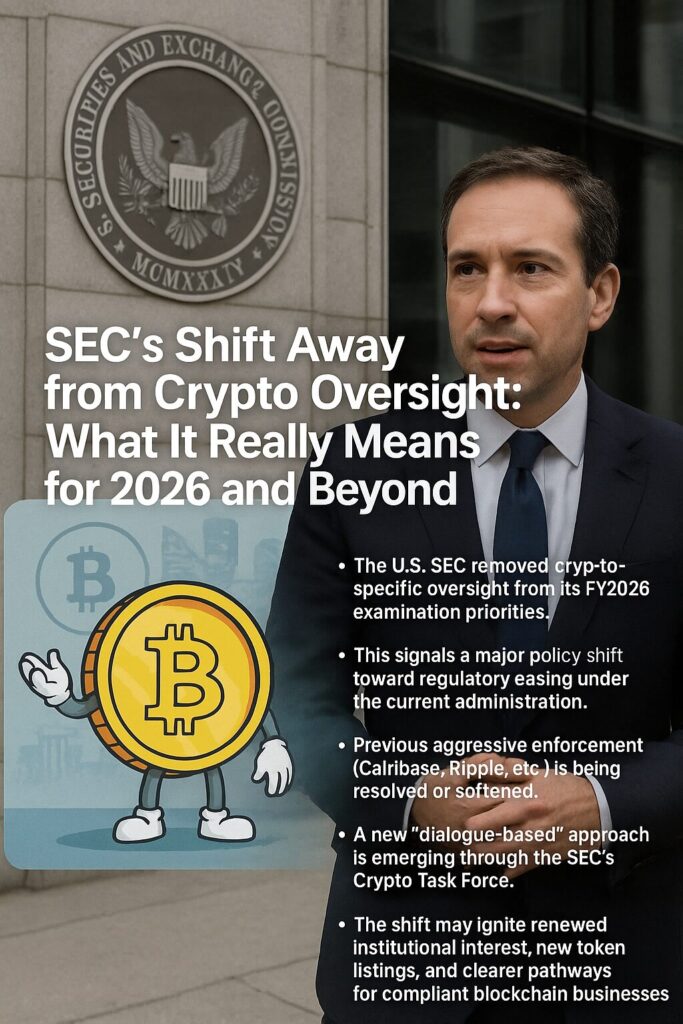
Main Points :
- The U.S. SEC removed crypto-specific oversight from its FY2026 examination priorities.
- This signals a major policy shift toward regulatory easing under the current administration.
- Previous aggressive enforcement (Coinbase, Ripple, etc.) is being resolved or softened.
- A new “dialogue-based” approach is emerging through the SEC’s Crypto Task Force.
- The shift may ignite renewed institutional interest, new token listings, and clearer pathways for compliant blockchain businesses.
- Broader market activity—from tokenization to real-world asset (RWA) platforms—aligns with this deregulatory trend.
I. Introduction — A Pivotal Regulatory Turning Point
On November 18, the U.S. Securities and Exchange Commission (SEC) released its examination priorities for Fiscal Year 2026. For the first time in several years, the document did not include any dedicated section on cryptocurrency markets, digital asset volatility, or crypto-related service providers.
During the previous administration, crypto was repeatedly labeled as a high-risk area often associated with non-compliance, creating an environment of heavy enforcement. The 2026 announcement, however, reflects a fundamentally different regulatory philosophy—one that prefers market development, structured dialogue, and predictable oversight over punitive actions.
This change is already visible through:
- withdrawal of the SEC lawsuit against Coinbase,
- settlement with Ripple Labs with significantly reduced penalties,
- the launch of a Crypto Task Force intended not as an enforcement arm, but as a communication bridge between regulators and industry.
For investors, developers, and institutions—particularly those exploring new assets, new yields, and applied blockchain solutions—this marks a structural turning point.
II. Why the SEC Removed Crypto From Its Priority List
1. A Shift in Political and Regulatory Climate
The current administration has embraced a more market-friendly direction. Chair Paul Atkins emphasized that SEC examinations should never feel like a “trap,” insisting on transparency in supervisory expectations.
Removing crypto from the priority list accomplishes two things:
- De-escalation of fear-based enforcement
Firms are less likely to face sudden, ambiguous penalties. - Reframing crypto as a normal financial sector
Instead of an exceptional “high-risk” product category, crypto becomes one of many asset classes supervised through existing legal frameworks.
2. Redirecting Regulatory Attention
Instead of crypto-specific oversight, the SEC’s FY2026 priorities focus on:
- fiduciary duties of investment advisers,
- conduct standards,
- custody rules,
- new privacy and customer-data protection requirements.
This means the SEC now views compliance risks broadly across the financial ecosystem—not uniquely concentrated in digital assets.
III. Impacts on the Crypto Industry and Investors
1. Enforcement De-risking and Business Expansion
The retreat from aggressive enforcement allows companies to:
- re-open previously delayed projects,
- expand product lines (staking, custodial integrations, tokenized instruments),
- launch new tokens or utilities with reduced regulatory friction.
2. Institutional Capital Re-enters
Historically, institutions delayed crypto involvement due to SEC uncertainties. The policy shift will:
- accelerate tokenization of real-world assets (RWA),
- encourage banks and brokers to reintroduce blockchain-based products,
- expand professionally-run OTC desks, ETF markets, and custody platforms.
3. U.S. Exchanges Gain Competitive Ground
The previous pressure pushed activities offshore. With easing:
- U.S. exchanges may regain lost liquidity,
- onboarding processes for new tokens may streamline,
- compliance costs may decrease as reporting clarity improves.
IV. Market Trends Supporting This Shift
To contextualize the SEC’s move, we review broader crypto market trends seen throughout 2024–2025:
1. Global Tokenization Boom
Major institutions—including BlackRock, Franklin Templeton, and Singapore’s MAS—expanded their tokenized financial products.
RWAs have grown into a $10B+ market (USD).
2. Bitcoin and Ethereum Institutionalization
ETF approvals in multiple jurisdictions increased regulated inflows.
With U.S. regulatory pressure easing, derivative products and structured crypto notes are expected to proliferate.
3. U.S. Political Realignment
Regulatory agencies now favor innovation, supporting:
- economic competitiveness,
- technological sovereignty,
- the reduction of capital flight to offshore jurisdictions.
4. Shifts in Market Structure
DEX liquidity improved alongside L2 ecosystem growth, but institutional traders still prefer regulated venues.
The SEC’s easing shifts the balance back toward compliance-friendly centralized exchanges.
V. Chart: SEC’s Crypto Oversight Priority Decline (2023–2026)
Insert Location:

This simple trend visualization illustrates how crypto oversight moved from an extremely high-priority risk area (~80/100 in 2023) to a minimal one (~10/100) projected for 2026.
VI. How This Change Affects Builders, VASPs, and Wallet Providers
For developers building non-custodial wallets, OTC engines, token ecosystems, or enterprise integrations, this shift enables:
1. Clearer Regulatory Scope
Crypto is now governed within existing securities laws—not through special enforcement categories.
2. Reduced Fear of Retroactive Enforcement
This is especially crucial for:
- token issuers,
- wallet providers,
- liquidity platform operators,
- staking product teams.
3. Easier Dialogue With Regulators
The SEC’s new Crypto Task Force focuses on:
- guidance,
- structured consultation,
- sanity-checked compliance pathways.
VII. What Risks Remain
Despite the easing, the industry must be mindful of:
- consumer protection rules,
- anti-fraud provisions,
- AML/CFT requirements,
- disclosures for tokenized instruments,
- proper custody frameworks for custodial products.
In short:
Crypto is not deregulated — it is normalized.
VIII. Conclusion — A Long-Awaited Regulatory Opening
The SEC’s removal of crypto from its FY2026 inspection priority list represents:
- the largest regulatory thaw in U.S. crypto history since the 2017 ICO era,
- a shift from enforcement to structured cooperation,
- a significantly improved environment for institutional capital and real-world blockchain deployment.
For investors looking for new assets, for builders exploring new revenue models, and for enterprises implementing blockchain infrastructure, 2026 marks the beginning of a more predictable and growth-oriented era.

